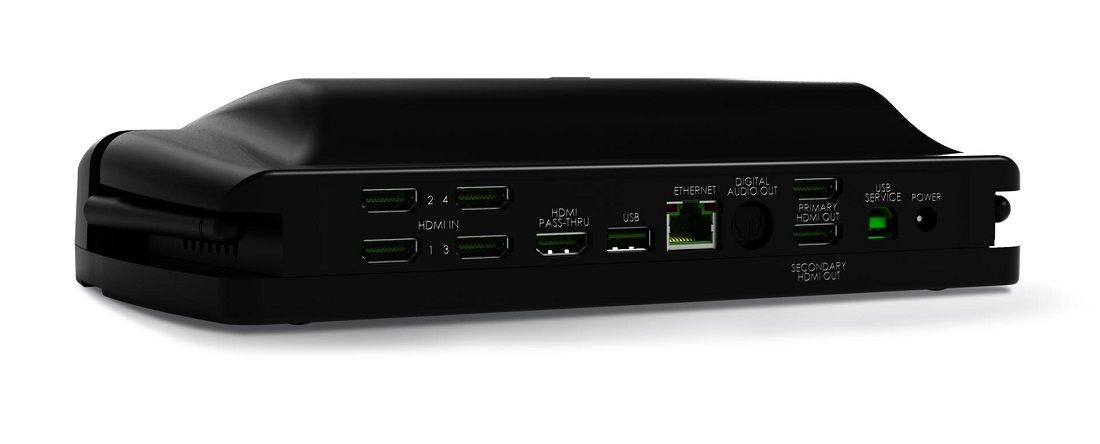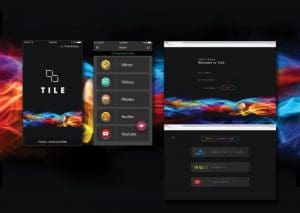Nowhere else in the business world has AV technology had a greater impact than boardroom meetings. The new DVDO Tile collaboration system helps modern businesses work together.
DVDO, a relatively new manufacturer to the commercial AV market, brings years of experience in consumer electronics as a developer of video processing and signal management components.
The DVDO Tile is a small-footprint, portable collaboration system that can also permanently install. I tried the Tile in a residential system, utilizing multiple sources and configurations. This AV product review reflects my thoughts after using it at home.
DVDO Tile Features & Installation
The collaboration system incorporates five HDMI 2.0 HDMI inputs that support 4K sources, and also offers a pair of USB inputs and a pair of HDMI outputs.
DVDO says the Tile includes wired and wireless network connectivity to allow multiple users to cast 1080p video streams to as many as four onscreen tiles (“windows”) simultaneously.
In addition, the company supports the unit with iOS, Mac, Android and Windows apps that provide moderator mode and customization capabilities like the re-positioning of tiles, text and re-layering of tiles.
The DVDO Tile arrived at the Commercial Integrator office in a small box. I unpacked the Tile at home, finding a power cable and an HDMI cable to get users up and running with a single wired source.
After unpacking the product, I unplugged a Dish Network 4K Joey set-top box (STB) and Apple TV from their respective inputs that were connected to a 4K Vizio television.
Taking the cables from the two wired sources, I plugged the Apple TV into the Tile’s HDMI one input and plugged the 4K Joey into the Tile’s second port.
Using the supplied HDMI cable, I plugged that cable into the Tile’s HDMI output and into the HDMI input number four of the Vizio television.
With the wired sources set, I plugged in the Tile’s power and downloaded the companion app to an Apple iPad Mini 4 and an Apple iPhone 8.
After turning the TV on and selecting input four on the television, I was greeted by a main screen from the Tile that outlined a four-step setup process. That involves creating user passwords, placing the Tile on a network and naming the unit.
I estimate it took me roughly 30 to 35 minutes to set up; but this time could be shaved down if a user is already familiar with the product.
DVDO Performance & Final Thoughts
The Tile provides users with the ability to operate in a “mirrored” mode or a Wi-Fi mode.
The mirror mode replicates/displays the content of a connected device such as an iPad, while Wi-Fi mode connects to a network for streaming video and various other options. [related]
Mirror mode is nice in the event that a network is unavailable. Using the app, I was able to connect to the device and stream photos, videos and other content in the tiles and move the tiles around as needed.
I found navigating between sources is as easy as pressing the home button. Switching to the Wi-Fi mode, I went back to main page of the app by pressing the home button and went into the settings, which is located in the upper left corner of the app.
Some other functions include the connected Apple TV and Dish sources and the built-in YouTube streaming that’s bundled into the app.
Wanting to try the desktop version of the app, I decided to download the DVDO Tile app for OSX. To download that, I went to the DVDO website, clicked “get apps,” and followed their directions.

With the desktop app installed on my MacBook Pro running a Chrome browser, I found the download and overall user experience similar to the mobile versions.
Based on my time with the desktop and mobile app, I don’t think anyone would have any issues going between their mobile products and computers when using the Tile.
My only apprehension with the DVDO Tile isn’t related to the product—it’s the network the product could live on if used in Wi-Fi mode.
I was having router issues that were slowing down my network speeds dramatically and I found the Tile was affected by the router. Resolving the router issues made the Tile operate better, but the network speed underscored the importance of a quality network when using the Tile in Wi-Fi mode.
While writing this AV product review, I am reminded of the experience I’ve encountered with Apple’s original AirPlay wireless technology.
AirPlay and the Tile can run great on networks capable of supporting wireless streaming from device to device, but if the network is busy or if the network simply isn’t up to the task, it will affect the user experience.
This point could be a great conversation starter for integrators to introduce the topic of networks to an installation.
Realistically, most users would be crazy not to listen to any type of network upgrade suggestion, but some will reject it. If they are unsophisticated or unwilling to acknowledge the quality of their networks, they could blame any kind of lagging performance on the Tile.
In conclusion, this AV product review is a positive one: the DVDO Tile is a great entry-level collaboration system that offices of just about any size can use to easily share content and foster productive joint meetings.











